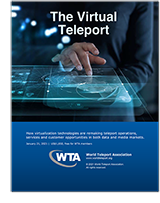The World Teleport Association (WTA) today released The Virtual Teleport, a new research report that examines the growing adoption and impact of virtualization on the teleport and satellite sector. The report explores the extent to which teleport operators have embraced virtualization, its benefits, the barriers and challenges it presents, the opportunities it creates, and what the future might hold. The Virtual Teleport was sponsored by Kratos.
“Virtualization is creating new operating models for ground segment,” said executive director and report editor Robert Bell, “with the rise of ground-segment-as-a-service companies. But that is only the most obvious sign of a digital transformation that challenges every teleport operator while opening new potential for revenue growth, geographic expansion and greater profitability. The business of the teleport will be very different in the not-to-distant future than it has been in the past.”
WTA members can access the report for free by signing in to their accounts on the WTA website. Non-members may purchase the report for $1650. Members may directly download the report by following this link.
More about The Virtual Teleport Virtualization is well established in terrestrial IT and communications, but it has only recently begun to catch on with teleport and satellite operators. There are many reasons for it: sunk investment in older infrastructure and technology, a competitive history of proprietary standards for equipment, sluggish adoption among the teleport equipment supplier base, and a long industry tradition of operating stand-alone, closed-loop systems.
Virtualization is well established in terrestrial IT and communications, but it has only recently begun to catch on with teleport and satellite operators. There are many reasons for it: sunk investment in older infrastructure and technology, a competitive history of proprietary standards for equipment, sluggish adoption among the teleport equipment supplier base, and a long industry tradition of operating stand-alone, closed-loop systems.
But this reality is changing as satellite and teleport operators learn the virtues of virtualization, including significant cost savings, flexibility and network scalability. An even greater factor is the opportunity to better integrate with customers, vendors and partners for whom virtualization is an established way of doing things. The degree of virtualization varies among operators, but there is general agreement that the trend will pick up steam in the coming years. There is simply too much to gain and too much to lose by maintaining the status quo, especially as the industry vies for new customers in an increasingly competitive environment and seeks to integrate more closely with the broader terrestrial communications grid.
In researching this report, WTA solicited and received input from more than a dozen teleport industry executives and technology experts, who offered a wide range of viewpoints on the subject. For more information go to: www.worldteleport.org
New York City, NY., January 21, 2021





